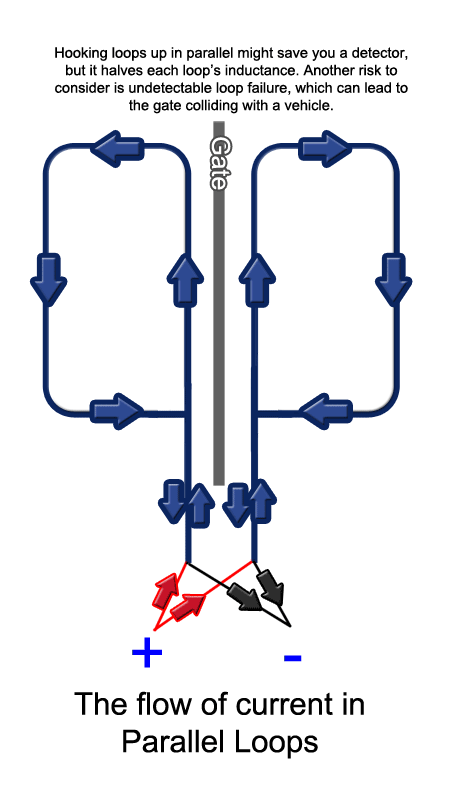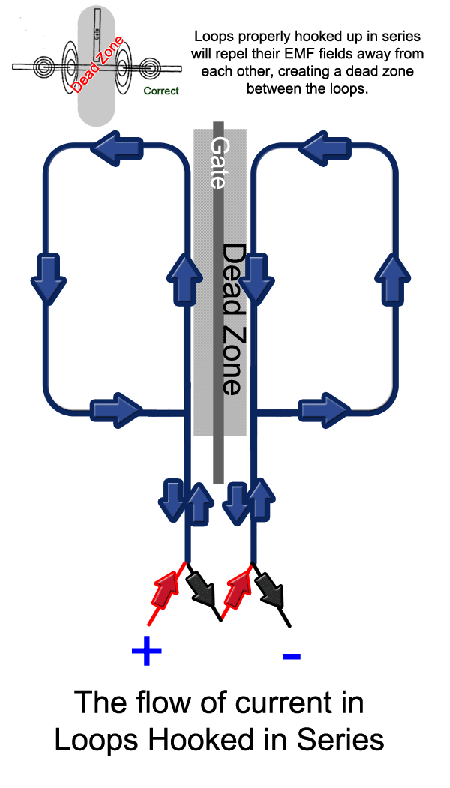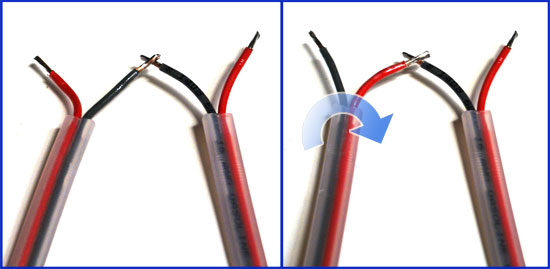Educational Articles
LOOPS AND THE EFFECT OF PARALLEL, SERIES, AND PHASING
Understanding loop phasing and detector sharing are two tricks that can put you ahead of the competition, and make you an expert in the eyes of your customers. Learning how to properly connect two loops to the same detector and the effects of loop phasing can save you the cost of a detector and allow you to install loops in tight spaces (such as a short driveway).
Inductance loops are commonly installed on each side of a door or gate as a method of vehicle detection. It is a common misconception that inductance loops detect either pressure or magnetism, as their name implies inductance loops detect changes in inductance also known as the change of current or frequency. When a loop is energized invisible Electric Magnetic Fields (EMFs) are created around the wire. Detection occurs when a vehicle enters the EMFs and a percentage of the loops energy is absorbed into the vehicle, the detector will notice the change and perform the desired function.
It is important to keep in mind that only loops sharing the same function can be connected to the same detector, which means a reverse loop and exit loop would still need to have independent detectors. There are two ways to connect two loops to the same detector, they can either be connected in series or in parallel. The proper way to connect two loops to the same detector is to connect them in series.

Loops connected in parallel can jeopardize the safety of your gate or door. If one of the loops in a parallel circuit were to fail the detector will continue to operate with only the functioning loop without any indication of the other loop’s failure. Essentially, a loop could go out on the system and nobody would notice until the gate or door makes contact with a vehicle. Having two loops hooked up in parallel also reduce their network inductance by 50%, meaning they are much less sensitive.

The only proper way to connect multiple loops to one detector is by connecting them in series. To properly make a series circuit between two loops connect one wire of each loop to the detector and the other wire of each loop to each other, so that the flow of current passes through one loop then through the other, like making a chain. Changing how many loops are connected to one detector will augment a loop’s detection strength. In a series circuit the chain created makes the two loops perform like one large loop. Since the detection area is doubled when two loops are connected in series to one detector, a larger percentage of change in the loop’s inductance is required for a detection to occur. Series circuits are not often used with loops larger than 44ft (a 6’ x 16’ pattern) because detecting smaller size vehicles is harder. If loops connected in series have a hard time detecting a vehicle the solution is simple, take the loops out of series and hook them up to their own detectors or install a detector that has a wider range of sensitivity.
The main reason why two loops sharing the same function are connected in series is to save the cost of an additional detector, but there are other valuable benefits. Normal applications require loops to be installed 4ft away from the gate/door on each side to prevent detection of the gate/door itself, loops hooked in series and properly phased can allow the loops to be installed as close as 2ft on each side. Pushing loops closer together provides better coverage of the closure area and could allow loops to be installed in restricted space.
Loop phasing is the effect describing the push and pull of the loop’s EMFs (detection area). Proper loop phasing is achieved by making sure current flows in the same direction in both loops (such as both being clockwise or counter clockwise). Loop phasing’s effect is similar to magnets. If the loops are properly phased the EMFs repel against one another creating a dead zone between the loops and causing the EMFs to stand taller. If the loops are not properly phased the EMFs are pulled down and towards one another often resulting in the gate itself being detected. Just like magnets, when the loops are far enough apart loop phasing does not have any effect. This is why loop phasing is only present when loops are hooked in series on a slide/vertical gate or door, close enough to have an effect on the other loop. Loop phasing is not present on swing gates.
You may be wondering how you can tell which direction the current is flowing in a loop, BD Loops’ direct burial loops have the current direction printed on the wire, and our saw-cut loops can only be installed one way (black side up) which causes the current to flow in the same direction for all loops. If you are wrapping loops yourself, you can insure that the current is flowing in the same direction in both loops by wrapping them the same way (clockwise or counter-clockwise) and marking one of the lead-in wires.

If you find that you have installed loops with the current flowing in opposite directions and the gate or door is being detected don’t panic! The solution is simple, unhook the loops from the detector and hook up the lead-ins differently to swap the polarity of the loops.
Hook multiple loops to the same detector on your next job and save the cost of a detector. Remember that loop phasing only applies to two loops serving the same function hooked in series to the same detector on a slide/vertical gate or overhead door. If you have any questions you would like to ask the loop experts please email us at: team@bdloops.com or call 714-723-0946.
BD Loops
The Loop Experts!
BD Loops was founded in 2001. Their preformed loops and accessories are designed with the installer in mind. BD Loops offers a complete loop system solution including preformed direct burial loops, preformed saw-cut loops, loop sealant, blades, testing devices, and installation tools. BD Loops has a reputation for reliability and ease of installation. They pride themselves on the quality of their products and their commitment to providing excellent customer service and support. BD Loops preformed loops are made in the USA at their facility in Placentia, CA.

